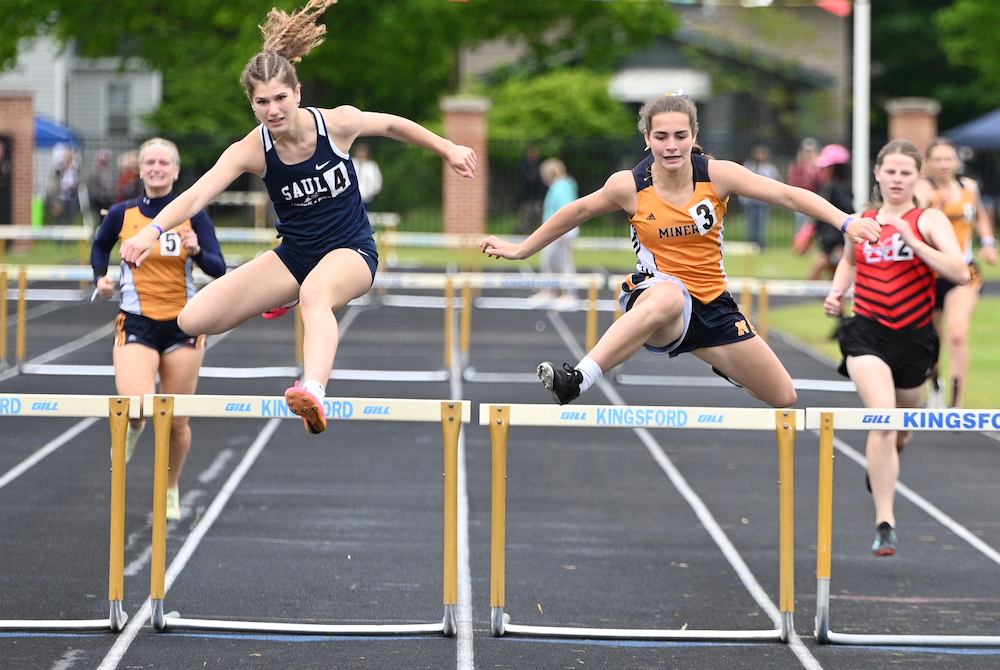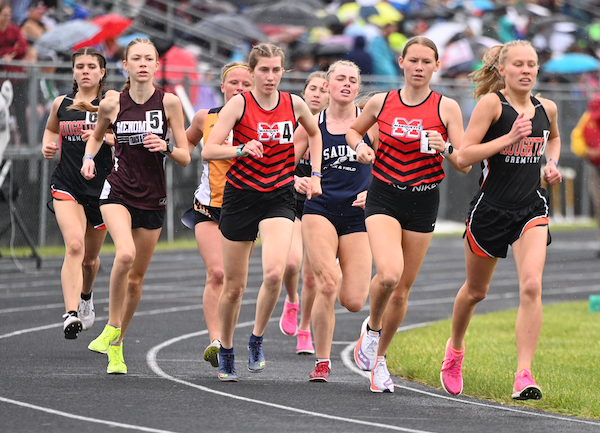
Track Gaining Speed Toward Future with Electronic Starting Devices
By
Steve Vedder
Special for MHSAA.com
May 23, 2023
Aubrey Greenfield thinks it might be the perfect time to reevaluate 130 years of tradition.
For a number of reasons, from technical to personal, the Oxford senior sprinter believes it makes sense for the crack of a starting pistol to be eliminated from high school track meets.
Because track meets would benefit in various ways from lowering costs to easier setup at meets to the human factor of competitors not having to flinch at the crack of a pistol shot, Greenfield believes the sport has a chance to embrace new technology – electronic starting devices (ESD).
In essence, an ESD replaces the starting pistol with a light flash, tone sound or both to begin a race.
"High school sports should put the athlete first," Greenfield said. "We should promote sports, and eliminating starting pistols promotes health in terms of PTSD or trauma for athletes and spectators and that would be good. I would like to think people would say that's a good idea."
In fact, Greenfield would go as far as to say if there was not an implementation of electronic starting devices, many of her teammates would have considered giving up the sport.
"If it's something that helps us compete safely, we're all for it," she said.
Greenfield's opinion apparently is spreading. Michigan High School Athletic Association senior assistant director Cody Inglis said the use of ESD makes it both affordable for meet starters and sensible for athletes and fans to rethink the use of starting pistols. While the MHSAA is not mandating electronic starting devices, it does promote the use of what Inglis calls "emerging technology." He notes that ESD are becoming the norm for organizations such as USA Track & Field, the NCAA and an increasing number of high schools.
 "I think we have to embrace new technology, and we think this will be something that takes hold," Inglis said.
"I think we have to embrace new technology, and we think this will be something that takes hold," Inglis said.
A key part of embracing ESD is the human element. The tragic Oxford High School shooting Nov. 30, 2021, that took the lives of four students while injuring seven others should not be relived even for a fleeting instance at a high school sporting event. Oxford athletic director Tony DeMare said the school began using ESD at every meet, including the MHSAA Lower Peninsula Division 1 Finals last June. He said that decision was embraced by virtually all schools Oxford encountered.
"We were very convinced that the alternative (of ESD) would promote a healthy attitude," DeMare said. "We were overwhelmed with the positive response. If a school was on the fence about it or might not be for it, I think we've started to see the tide turn in favor of people willing to listen and learn about electronic starting devices."
Inglis said the MHSAA is acutely aware of what the crack of a starting pistol can mean to athletes and fans.
"It's unimaginable what Oxford went through, and this is a small way we can help," he said. "We look at a (starting pistol) and think, ‘Could we do something else?’ It's a way of helping to solve a problem."
Over the last several years, the MHSAA has embraced finding an alternative to starting pistols. Inglis noted the discussion started with the cost and diminishing availability of 32-caliber ammunition that meet starters use. A box of ammunition, if it can be found, is around $75 a box.
In addition to cost, there is potential damage from excessive exposure to 150-plus decibels of sound generated by the traditional 32-caliber blanks. Medical studies show damage to ears caused by decibel levels above 120 dB.
The tragedy at Oxford accelerated the conversation.
Inglis said the cost of ESD can be likened to a school sinking money into artificial surfaces at football fields. Yes, there is a great cost at first, but over time money is ultimately saved. An ESD system itself ranges between $200 and $500. Speakers also may need to be purchased, but with ESD starting events like the 800 and 1,600-meter relays positioned near the outside lanes 8, 7, 6 and 5 would result in improved hearing by athletes at the start of a race.
There is one challenge with ESD that track administrators are working to overcome – lighting conditions that lessen the ability to see the ESD’s LED light or strobe when the button is pressed by a starter to begin a race. But that vision difficulty resulting from clear blue skies and backgrounds of setting suns can be substantially improved by incorporating a black background with an ESD – something as simple as a starter holding up black cardboard behind the lighting mechanism at the start of an event.
Inglis said when all factors are considered, the use of ESD makes sense.
 "With the climate we live in nowadays, no lookalike guns is good," he said. "We're not mandating this. But people are saying this is affordable."
"With the climate we live in nowadays, no lookalike guns is good," he said. "We're not mandating this. But people are saying this is affordable."
While switching to ESD would break 130 years of tradition, the timing could be a step forward, said Jeff Hollobaugh, co-author of the book "The Fleet Feet of Spring: Michigan's High School State Championships in Track & Field." He said while no definitive answer is possible, it's likely starting pistols were used at the inaugural state meet at the Jackson Fairgounds in 1895. The meet, which included events like tossing a 16-pound shot put, bike races and a 100-meter sprint, was sponsored by the Michigan Interscholastic Athletic Association (a predecessor to the MHSAA) and comprised mostly of the state's larger schools.
Hollobaugh's sentiments echo what many involved in today's high school track & field believe in terms of making a transition from starting pistols to electronic starting devices.
"It's a change, not necessarily good or bad, just different," he said. "It's not a drastic change, but it will take some getting used to. But it is the future. In the end, we'll all be fine."
DeMare believes the future of high school track will definitely include ESD.
"Our desire is that the practicality and sensibility of this will overcome the alternative," he said. "I think we'll see the automation and electronics taking hold of certain elements in track, and people will embrace it."
PHOTOS (Top) Runners watch official Bertha Smiley as they prepare to begin a race during last season's Lower Peninsula Division 1 Finals at Rockford. (Middle) An electronic starting device provided by VS Athletics was used to start those races. (Below) Smiley sets to begin an event. (Photos provided by David Kuderka/VS Athletics.)

Sault Ste. Marie Girls End 23-Year Championship Wait with UPD1 Win
By
John Vrancic
Special for MHSAA.com
June 2, 2024
KINGSFORD — The Sault Ste. Marie girls made a statement here Saturday while earning their first Upper Peninsula Division 1 Track & Field Finals title since 2001.
Sault scored 117 points, followed by Negaunee with 94 and Gladstone at 65.
The Blue Devils placed 1-2 in discus, won by senior Katie Anderson at 115 feet, 3 inches, with junior Annabelle Fazzari uncorking a runner-up toss of 101. Freshman Ahnaka Oshelski added a first in the 300 hurdles in 48.29 seconds, followed by Negaunee freshman Sadie Rogers (48.30) and Marquette freshman Chloe Jackson (49.56).
Oshelski also helped the Blue Devils take the 800 relay (1:49.55).
“Our handoffs were a little rough, but I just ran as fast as I could (in the 800),” freshman Grace Mayer said. “It feels great to come away as U.P. champions.”
Mayer was also part of the winning 1,600 relay, clocked at 4:17.4.
Fazzari provided the Blue Devils with a second place in the 100 hurdles (17.07) and a third in shot put (34-0).
Rogers won the 100 hurdles in 16.65 seconds, and Negaunee classmate Keira Waterman placed first in the 400 (59.23) and 800 (2:28.2).
“I didn’t really know what to expect here today,” Rogers said. “I had a good start and just pushed myself real hard. I could hear the crowd. It was very important for me to win this one. I also thought my chances in the 300 were pretty good. I knew I had to push it.”
 Gladstone set a UPD1 Finals record in the 400 relay at 50.78, shaving basically ⅓ of a second off the previous record (51.11) run by Marquette three years ago.
Gladstone set a UPD1 Finals record in the 400 relay at 50.78, shaving basically ⅓ of a second off the previous record (51.11) run by Marquette three years ago.
The Braves were led by junior Jacie Tuljus, who anchored that relay, won the 100 (12.75) and 200 (26.85) and was runner-up to Waterman in the 400 at 1:02.54.
“My starts were slow, but what we did in the 400 relay was good for today” Tuljus said. “Everybody was pretty hyped. We’re happy with it. Overall, I’m happy with the way everything went.”
Marquette sophomore Ella Fure took the 1,600 (5:31.33), followed by Houghton sophomore Tessa Rautiola (12:13.39) and Marquette junior Monet Argeropoulos (5:37.27).
Rautiola then captured the 3,200 (12:13.39), followed by Fure (12:13.46) and Argeropoulos (12:23.91)
“I just wanted to have fun and asked God to pull me through,” Fure said. “I knew if I just trusted God, He would get me through. My mom is pretty sick and couldn’t be here. I just wanted to do this for her.”
Rautiola also helped the Gremlins win the 3,200 relay in a season-best 10:10.38.
“Our school record is 10:08,” she said. “We didn’t get the record this year, although we’re absolutely happy we won. There was miscommunication in the exchange zone which created some confusion. We weren’t in the proper place for one of our handoffs. Otherwise, I think we would have had it.”
Ishpeming Westwood junior Faith Spiroff became a double winner, taking high jump (5-0) and long jump (16-4½).
Other winners were Manistique senior Danielle Lund in shot put (38-7¾) and Calumet senior Caitlyn Strom in pole vault (10-0), where she edged Westwood junior Lexi Olson on a tie-breaker. Houghton freshman Amy Sziber won the adaptive shot put, 100 and 200 events.
PHOTOS (Top) Sault Ste. Marie's Ahnaka Oshelski, left, edges Negaunee's Sadie Rogers by one hundredth of a second to capture the 300 hurdles title Saturday. (Middle) Houghton's Tessa Rautiola (2) leads the 1,600 with Marquette's Ella Fure (1) and Monet Argeropoulos (4) following close behind. Fure won the race, with Rautiola taking second. (Click for more from Cara Kamps/RunMichigan.com.)

